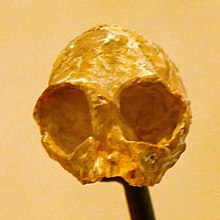Tremacebus
Appearance
You can help expand this article with text translated from the corresponding article in German. (February 2020) Click [show] for important translation instructions.
|
| Tremacebus | |
|---|---|

| |
| Skull of Tremacebus harringtoni | |
| Scientific classification | |
| Domain: | Eukaryota |
| Kingdom: | Animalia |
| Phylum: | Chordata |
| Class: | Mammalia |
| Order: | Primates |
| Suborder: | Haplorhini |
| Infraorder: | Simiiformes |
| Family: | Aotidae |
| Genus: | †Tremacebus Hershkovitz, 1974 |
| Species: | †T. harringtoni
|
| Binomial name | |
| †Tremacebus harringtoni (Rusconi, 1933)
| |
Tremacebus is an extinct genus of New World monkeys from the Early Miocene (Colhuehuapian in the SALMA classification). The type species is T. harringtoni.
Description[edit]
Tremacebus was about 1 metre (3.3 ft) in length, and would have resembled a modern night monkey, to which it may have been related,[1] though possibly a stem aotid.[2] However, its eyes appear to have been smaller than the modern species, CT scans of the cranium suggest a relatively small olfactory bulb and poor sense of smell, compared with night monkeys. These features suggest that it may not have been nocturnal.[3] It had an estimated body mass of 1.8 kg (4.0 lb).[2]
Only a few fossils have been found, including a skull from the Sarmiento Formation, Patagonia.[4]
References[edit]
- ^ Palmer, D., ed. (1999). The Marshall Illustrated Encyclopedia of Dinosaurs and Prehistoric Animals. London: Marshall Editions. p. 289. ISBN 1-84028-152-9.
- ^ a b Silvestro, Daniele; Tejedor, Marcelo F.; Serrano Serrano, Martha L.; Loiseau, Oriane; Rossier, Victor; Rolland, Jonathan; Zizka, Alexander; Antonelli, Alexandre; Salamin, Nicolas (2017). "Evolutionary history of New World monkeys revealed by molecular and fossil data" (PDF). BioRxiv: 1–32. Retrieved 2019-02-20.
- ^ Kay, Richard (2002). "Tremacebus harringtoni, Fossil Primate". Digimorph. UT Austin. Retrieved 2009-01-31.
- ^ Tremacebus at Fossilworks.org
External links[edit]




